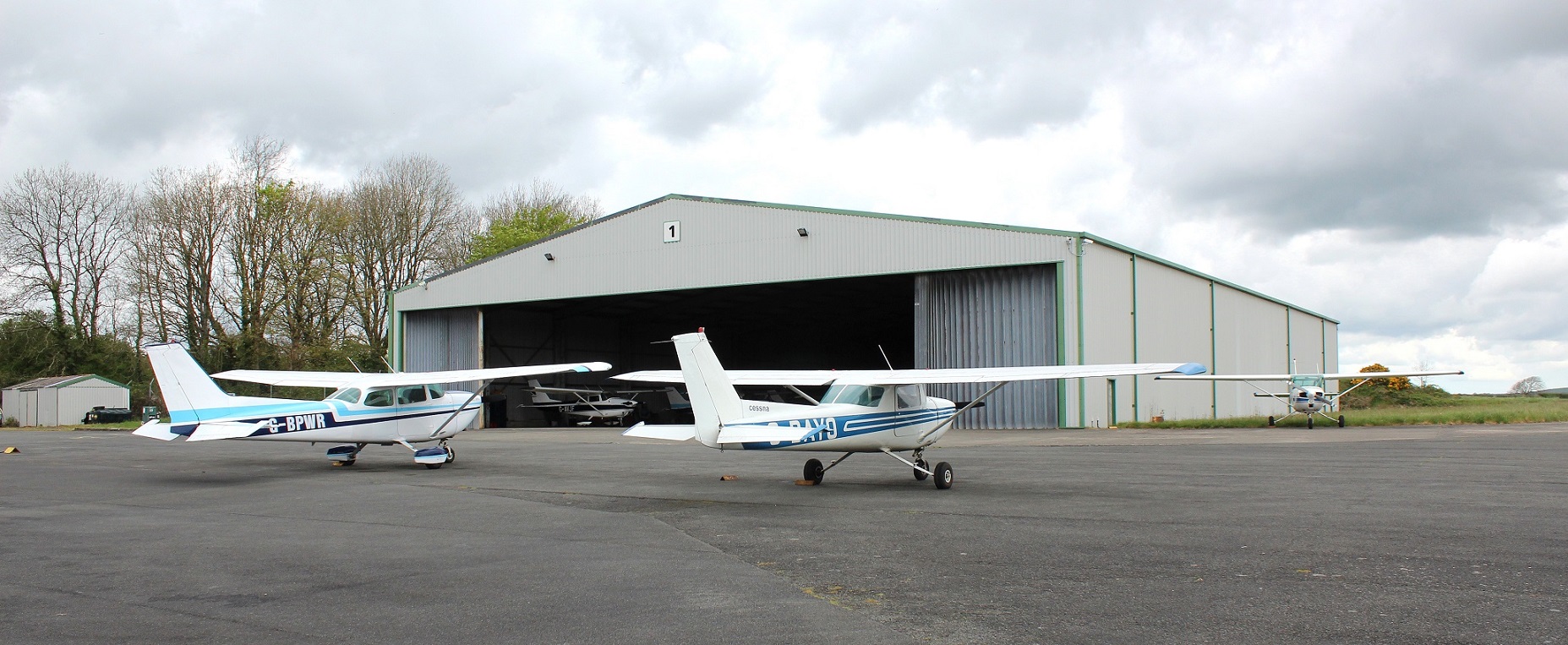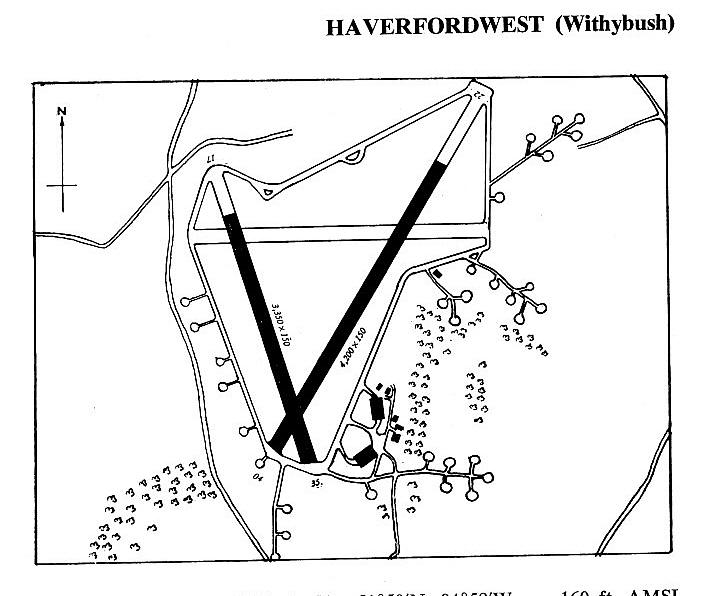Haverfordwest flying sites
Note: This map only shows the position of the WW2 airfield.
HAVERFORDWEST see also PORTFIELD
HAVERFORDWEST see also WITHYBUSH GENERAL HOSPITAL
HAVERFORDWEST: Temporary aerodrome (On the racecourse)
Note: Both of these pictures were obtained from Google Earth ©
NOTES: Some time ago I made this request: "On the 29th August 1932 Sir Alan Cobham’s National Aviation Day UK Display Tour performed at/in/near Haverfordwest. Did they use the Landing Ground listed below or another site? Possibly PORTFIELD?"
In August 2020 I was kindly contacted by Mr Andrew Harvey, who lives in Haverfordwest, and he informs us that the event was held on the racecourse. A tad more investigation reveals that the PORTFIELD aerodrome was indeed on the "old racecourse" site. (See seperate entry).
HAVERFORDWEST: Military aerodrome in WW2 later civil regional airport/aerodrome
(Previously known as WITHYBUSH AIRFIELD)
Note: All six of these pictures were obtained from Google Earth ©
Note:All pictures by the author unless specified.
PICTURE GALLERY IN 2017
Note: The faded inscription on the propellor memorial tells us that, recovered by divers in 1973, it is believed this came from the Westland Lysander V9444 that crashed into the sea on the 6th November 1942.
Military users: WW2: RAF Coastal Command 17 Group
1943 to 1945
No.3 (Coastal) OTU [Operational Training Unit] (Armstrong-Whitworth Whitleys, Avro Ansons, Vickers Wellingtons and Warwicks)
No.4 Refresher Flying Unit
Note: I think this is the only place I have come across this? An RFU - doesn't ring any bells elsewhere. A spin off it appears from No.7 OTU to deliver aircraft within the Coastal Command.
No.7 (Coastal) OTU (Vickers Wellingtons)
No.8 (Coastal) OTU (de Havilland Mosquitos and Vickers-Supermarine Spitfires)
516 Sqdn
Note: This was a quite unusal Squadron within the RAF, tasked with providing realistic air attacks for ground based troops. They flew Avro Ansons, Bristol Blenheims, Hawker Hurricanes, North American Mustangs (presumably only the early version?), and Westland Lysanders. But, I have no idea if all these types were flown here.
Note: No.20 and N.21 Aircrew Holding Units were based here also. Did they relate to flying activities by the OTUs? It would seem to make sense?
Later: Care & maintenance
Operated by: From 1952: Cambrian Air Services
1965: Pembrokeshire County Council
Note: It appears that the airfield was first licenced by the CAA in 1974.
1980s/1990s: Dyfed County Council
2000: Pembrokeshire County Council
Civil activities: Airline, GA business, private, training, and maintenance
British airlines: Post 1945: Cambrian Air Services
Charter/air taxi: Post 1945: Airswift (Wales)
Flying school: Post 1945: Haverfordwest Flight Centre, Haverfordwest School of Flying
Gliding: West Wales Gliding Association (1960s and 70s only?)
Note: This lovely period picture from a postcard was kindly sent by Mike Charlton was has an amazing collection. See: www.aviationpostcard.co.uk
Location: S of Great Rudbaxton village in WW2, (now known as Rudbaxton), just E of the A40, W of the B4329, about 2nm N of Haverfordwest
Period of operation: Military 1943 to 1945. Then civil from 1951 to 1957. Reopened shortly after?
Note: These maps are reproduced with the kind permission of Pooleys Flight Equipment Ltd. Copyright Robert Pooley 2014:
Runways: WW2: 04/22 1554x46 hard 10/28 1097x46 hard 17/35 1152x46 hard
1965: 04/22 1280x45 hard 17/35 1021x45 hard
1990: 04/22 1289x45 hard 09/27 1040x45 hard
2000: 03/21 1524x45 hard 09/27 1040x45 hard
SOME INTERESTING INFORMATION
In August 2020 I was kindly contacted by Mr Andrew Harvey who sent me this extract from the Western Mail & South Wales News published in the 22nd May 1951. He also sent a copy of the 1948 Ordnance Survey map obtained from the National Library of Scotland. He also sent an earlier map, before the airfield was built showing how the site closed two local roads - these being never re-instated. Although, this being said, the east-west roads were later reconnected by a diversion around the north side of the airfield.
Withybush aerodrome taken over
"Management of Withybush Aerodrome for Pembrokeshire County Council was officially taken over yesterday by Cambrian Airways, Ltd." (My note - this is incorrect - it was Cambrian Air Services. Cambrian Airways was formed in 1956). "Erected during the war for the R.A.F., the aerodrome was extensively used by Coastal Command and has several magnificent runways." (My note - three - see map above).
"The county council decided to utilise it for civil flying, thus linking up extreme West Wales with Swansea, Cardiff, and other parts of the country. Warm support for the project was given by local authorities in the county, including Tenby, who felt it will be a useful asset to the seaside town." (My note: But not offering, I would bet, a single pound note to help with the upkeep?)
"The county council have been widely commended on its enterprise in developing the airfield and they now become one of the few local authorities in the country to control an airfield. It is probable Haverfordwest Flying Club, formed in 1946, will be now be revised. By a coincidence, a native of Haverfordwest, Mr. William Evans, aged 30, manager of Newcastle-on-Tyne Flying Club, was the first to visit at the airport after it had been taken over yesterday."
Without too much doubt Pembrokeshire County Council had not appreciated just how much commitment, resources, and of course money, was required to keep an aerodrome fit for purpose, and had allowed it to become very run down.
Andrew Harvey also sent me another article from the Western Mail published on the 3rd October 1957.
Airport's future
"Engineers of the Ministry of Transport and Civil Aviation are finding out how much it will cost to make Withybush airport, near Haverfordwest, fit for flying again. But this does not mean that the Ministry are reopening the aerodrome. Big industrial developments at Milford Haven are responsible for this review of the airport, closed last year because it did not pay."
So interesting to see, is it not, that in those days a regional airport was not seen as being a civic amenity, alongside road and rail connections. And that, by and large, with the exception of Scotland of course, the attitude still applies today. (2020 - and the Covid 19 pandemic will not help).
NOTES: Cambrian Air Services ran a scheduled service into here on a London-Cardiff-Swansea-Haverfordwest service using Dragon Rapides from 1952 to 1956?
A listing in 1975 says it was privately operated and used by GA aircraft and for gliding.
In 1977 just five aircraft were listed as being based here: Auster 6A G-ASNB operated by the West Wales Gliding Co, Dornier Do 28B-1 G-ATAL operated by Richard Hayes Investments Ltd, Cessna F.172H G-AVJF, Beagle B.121Pup 1 G-AWKM and the Slingsby T.61A Falke G-AZHD of the West Wales Gliding Co. Ltd.
A PERSONAL MEMORY
In August 1989, not long after I gained my PPL, we visited friends who had moved more or less into retirement from Kent to this region. Needless to say I was fired up to fly and dragged my friend to HAVERFORDWEST very keen to show him what this flying business was all about. I met a certain wonderful person, (he was still around in 2005), who had a most robust attitude to flying little aeroplanes and has been applauded many times for his generosity - but I’m not too certain he always applied the letter of the law too precisely.
People like this man make life worth living, they really do, but they’re a dying breed, suffocated by often vindictive office dwelling ill-educated despots. I was lucky, I met this man in his prime. I’d expected to be checked out with an instructor at least, but instead he asked me if I’d forgotten how to fly! I think he was highly amused by my attempt to answer this question. Anyway, the result was he gave me a Cessna 150 to fly, (no check flight), saying this aeroplane cost them £700 to buy so please look after it! It had a climb prop fitted so I had to watch the RPM in the climb out and the cruise. That experience taught me so much about flying, the aeroplane was so different to all the C.152s I’d been trained on.
I had to learn very quickly and adjust, and I simply loved it; this little aeroplane G-AVAR really was so very different, I needed to learn pretty quickly, how this aircraft flew because, at first, I was going all around the sky.....well, a bit anyway. I now suspect it wasn't too well rigged after being restored from a crash. This was especially so because I obviously realised that I needed to land it once our flight was over! In fact, after a while (we flew for one hour twenty minutes), I soon got the hang of the 150 and a pretty standard approach did the the job. The main handling differences being in the take-off and cruise phase of flight. And so it worked out, with me delighted, proving to my friend that I could indeed fly, and delighted somebody had trusted me to do the deed!
The way I was taught to fly was to treat every type of aeroplane totally differently, and get checked out in detail. I can find no fault in this procedure, but, years later having flown types as diverse as the Letov Sluka single-seat microlight and the Antonov An-2, I did find it amusing to think back to this flight and how, due to my inexperience, the tiny variations in handling had seemed quite demanding. This said, to have had such an opportunity, definitely whet my appetite for trying other much more different types of aircraft, and I’m certain doing this flight from HAVERFORD WEST helped to improve my flying over the years.
The picture of Milford Haven was taken by my friend Philip Bernhard using my camera. This stretch of water is significant for this Guide (see MILFORD HAVEN and PEMBROKE DOCK) as it was used by seaplanes and flying boats for at least two decades.
OIL TANKER DISASTER
On the 15th February 1996 the large oil tanker Sea Empress ran aground just west of Pembroke docks Air Atlantique based their detergent spraying Dakotas here to help cope with the spillage.
COMMENTS FROM 2017
Although only making a brief visit on a rather dull day in early May 2017, (en route to catch the ferry in Fishguard), it was very nice to see that, since my last visit in 1989, this airfield has clearly prospered during the intervening years. Congratulations to all involved for achieving this and long may it continue.
Morgs
This comment was written on: 2021-01-10 02:22:24That 'brace of Isaacs Furies' were actually Wolf Boredom Fighters, built 'locally' by Peter Gronw and John Penny.
We'd love to hear from you, so please scroll down to leave a comment!
Leave a comment ...
Copyright (c) UK Airfield Guide






































